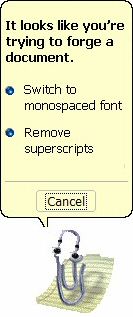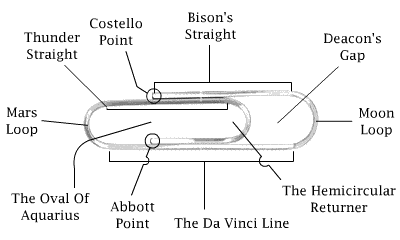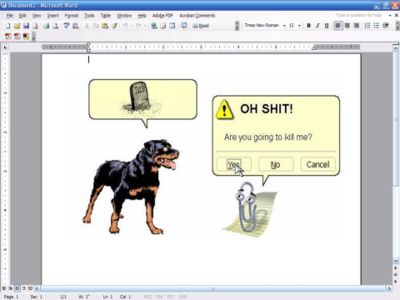Paper clip
The paper clip (or easily removable stainless elastic steel wire-based pressure induced friction and torsion binding device) is a complex and ingenious mechanism capable of fastening several pieces of paper together without the need for any kind of adhesive. It is used mainly by large industry, the only organizations capable of amassing enough money to buy them in bulk. It was invented by King George VI and Elvis Costello.
Specifications[edit | edit source]
Paper clips are silver, as it has been proven by the Professor of Paper Aggregation Technology at Queen's College Oxbridge that silver is "simply the best". He also claims that there are reams of paper living wild in the highlands of Scotland, so perhaps this information should not be taken at face value.
The smallest paper clip in the world could be fit 29,000,000,006 times onto the head of a pin, whereas the largest simply can't. Both are, according to the professor, "[simply] big enough".
Parts of the paper clip[edit | edit source]
The Costello Point[edit | edit source]
Named after one of the two inventors of the paper clip, the Costello Point is specially designed to let paper slip into the holding mechanism of the paper clip. It creates a gap between it and the Thunder Straight (see below) that allows thin objects (such as paper and, perhaps, wafer thin ham) to pass between the two without destruction of the paper itself. Previous incarnations of paper clips, utilizing the "razor point" instead of the Costello Point, were withdrawn due to damage caused to both paper and user.
The cross-sectional shape of the Costello Point is often described as circular when it is in fact an oval – the mysterious "quantum shape" that exists only in paper clips.
Bison's Straight[edit | edit source]
Bison's Straight is the feeding mechanism for the paper into the paper clip. It uses the concepts of Henry L. Bison, an American philosopher, who used Newton's gravitational theories to work out that paper would group together only if forced to by an external object. Bison died in 1967 in an accident while attempting to force one hundred pieces of cardboard into an experimental Einsteinian paper clip of relativity.
Deacon's Gap[edit | edit source]
Deacon's Gap is one of the two parts of the paper clip designed to let the paper "breathe". Without the Gap, the paper would turn all mouldy, brittle and disgusting. Named after the 10th Deacon of Scunthorpe, who suffered a similar fate.
The Moon Loop[edit | edit source]
The Moon Loop, directly opposite of the Mars Loop (see below), is the longest piece of curved metal on the paper clip. It is designed to ensure that neither side of the paper slides backwards, hence dislodging it from the mechanism and causing a Total Paper Catastrophe (or TPC). TPCs are the sixth-highest cause of death in the global workplace, after Stapler Intrigue and Coffee Spillage.
The Da Vinci Line[edit | edit source]
The Da Vinci Line is the longest piece of metal on the paper clip. It is based on a sketch by Leonardo Da Vinci, where he determines the exact dimensions of a rudimentary paper clip, several hundred years before the invention of the modern day model. The Da Vinci model differs in that it has a flamethrower attachment and an instrument for measuring the density of apples in a barrel.
The Mars Loop[edit | edit source]
The Mars Loop is the only part of the paper clip that is visible both from the front and from the back when fastening paper together. As such, it is the most important part of the mechanism, and also the part the most prone to failure. Early paper clip models were notorious for Mars Loop failures, so much so that Microsoft attempted to reinforce their paper clips with spare pieces of computer hardware. It was due to this that Mr. Clippy was born (but see below for the problems this created).
The Thunder Straight[edit | edit source]
The Thunder Straight works in conjunction with the Abbott Point and the Bison Straight to ensure that the paper stays in place.
The Thunder Straight is so called because, in earlier models, the mechanism was known to let out large static shocks to anyone who touched it. It was believed at first that friction between paper and metal was to blame, but it was soon noted that a paper clip factory had been built right next to the first ever static electricity power station (an experimental and eventually doomed government initiative whereby people dressed in nylon suits were forced to touch ... things).
The Hemicircular Returner[edit | edit source]
An extremely important part of the paper clip, this allows the Abbott Point to be connected to the Mars Loop and Thunder Straight without an unnecessary zigzag across the Oval of Aquarius. It is estimated that, without the Hemicircular Returner, the price of manufacturing paper clips would increase to such an extent that the entire world would be bankrupted within a couple of weeks. They would also look ugly.
The Abbott Point[edit | edit source]
Named after the second of the two inventors of the paper clip, the Abbott Point is in fact a rather useless part of the paper clip. It exists only because something is needed to fasten paper against the Da Vinci Line. Then again, if there were no Abbott point, the paper clip would continue past where the point currently is, spiraling farther and farther inside the Oval of Aquarius until critical mass is achieved and a black hole is created ...
Or so says the Professor of Paper Aggregation Technology at Queen's College, Oxbridge, whom most other scientists agree is two (if not three) sandwiches short of a picnic.
The Oval of Aquarius[edit | edit source]
Like Deacon's Gap, the Oval of Aquarius is a gap used to let the paper breathe. However, it also utilizes the quantum oval ideology, and therefore has much mythology attached to it. A Church of the Latter Day Paper Clippers has started up in the Deep South of America, while pagans around Stonehenge in the UK believe that the universe is one giant paper clip, and that the Earth is only part way along the Galactic Bison's Straight.
Strangely, the ancient Sanskrit symbol for "Obey Oprah" looks rather like a paper clip.
Clip Theory[edit | edit source]
Clip Theory is the study of all matter in the Universe and its relationship to paper clips. The first theorem states that any two sheets of paper can be held together with a single paper clip. The second theorem (technically the first corollary to the first theorem) applies to two clips' holding at least three sheets, the third (a.k.a. the second corollary) to three clips' holding at least four sheets, ad nauseam.
Paper clip usage[edit | edit source]
Although paper clips are intended for keeping pieces of paper together, not all paper clips are destined for this opportunity. A survey by the International Organisation Of Paper And Cardboard Collection, Fastening And Recycling (IOPCCFR, pronounced "Horace") has revealed that paper clips are used as following:
- Only 1.4% of paper clips are used for fastening paper. The rest are jammed under fingernails, or these other amazing uses.
- The biggest single use of paper clips is for cleaning out the meat under the fingernails (19.4%).
- This is closely followed by fixing broken circuitboards (15.6%).
- Behind this we have "creating crude rubber band catapults" (11.9%) and "removal of nasal mucus" (8.0%).
- Also, paper clips are used for "poking in the eyes of co-workers" (7.2%) and the "creation of a scale model of the Eiffel Tower" (6.8%).
- Miniature lightning conductors (5.9%)
- Torture for beginners (4.3%)
- Christmas presents (4.1%)
- Dentistry (3.9%)
- Rubbing together to create fire (3.4%)
- Replacement cocktail sticks for emergencies (3.3%)
- Headache cures (2.1%)
- Paper clip tiddlywinks (2.0%)
- Poem inspiration (-1.0%)
- Crude calculation for when a calculator is not at hand (0.6%)
- Attempting to take over the world in your own specially designed paper clip-powered mecha-robot (0.1%)
- Using it as a TV Antenna (0.01%)
It may be a surprise for you to learn that this list covers only 85.8% of paper clips. If this has already occurred to you, you have way too much time on your hands and should go outside and see the real world.
Paper clips are also useful for holding someone hostage when other weapons aren't available. They prove useful in this way in Schools, especially in Business Studies lessons.
Controversy[edit | edit source]
Fake clips[edit | edit source]
Some manufacturers have created facsimile paper clips that do not use ovals (rather, they use "extended circles"). The original manufacturer of paper clips, Papporinox GmbH (which also holds the patent on paper clips, ovals and for some strange reason lemons), sued several of these companies for tens of dollars in the U.S., although they settled out of court for an undisclosed sum (believed to be a voucher for $5 off a clock radio at Wal✽Mart).
Mr. Clippy[edit | edit source]
Papporinox has also sued Microsoft over their office assistant Mr. Clippy, not because they believed they owned the copyright but because they found it so bloody annoying.
“Mr. Clippy has performed an illegal operation and will now be shot.”
– Word
A message from Mr. Clippy[edit | edit source]
It looks like you're writing a letter! It looks like you're writing a letter! It looks like you're writing a letter! It looks like you're writing a letter! It looks like you're writing a letter! It looks like you're writing a letter! It looks like you're writing a letter! It looks like you're writing a letter! It looks like you're writing a letter! It looks like you're writing a letter! It looks like you're writing a letter! It looks like you're trying to kill yourself! It looks like you're trying to kill yourself! Need help?




